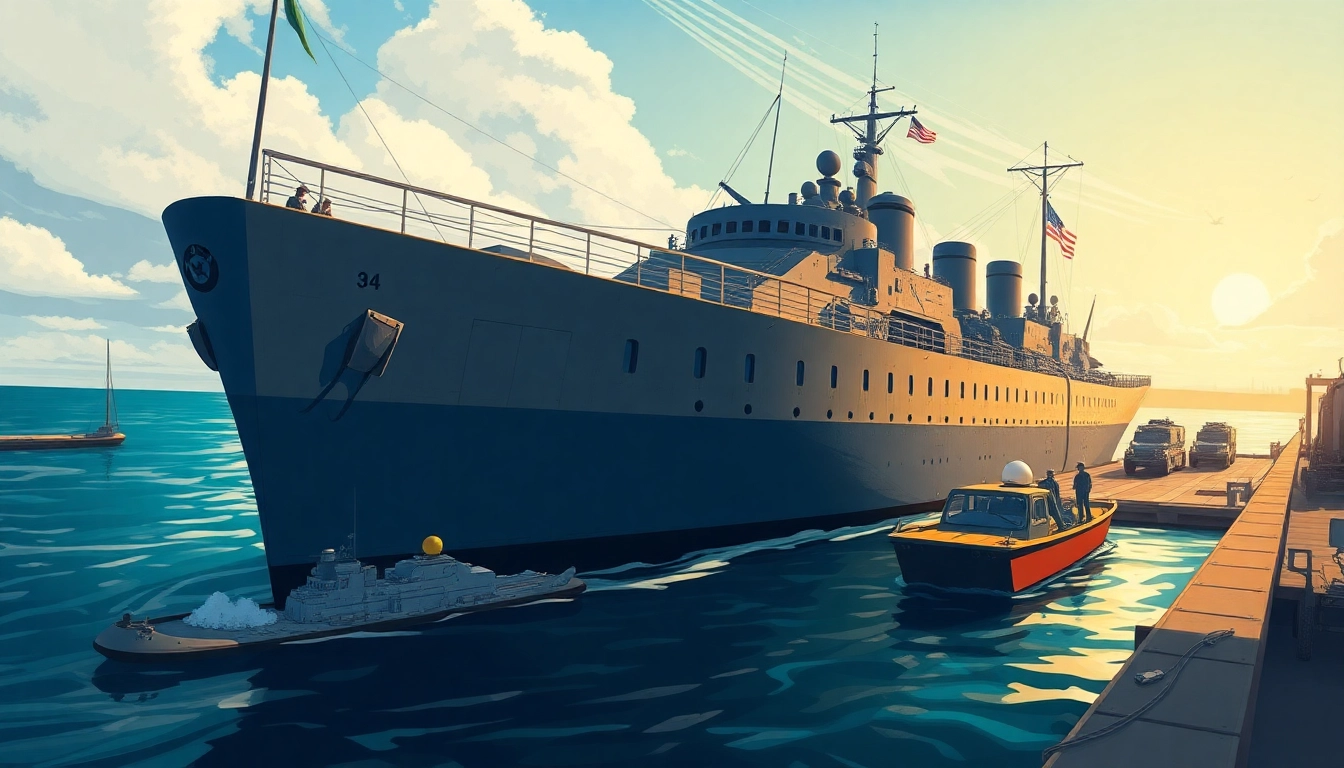Introduction to LSM44: Legacy and Impact
Overview of LSM44 and Its Historical Significance
The USS LSM-44, an exemplary vessel of the LSM-class ships, stands as a testament to the naval ingenuity of the United States during World War II. Commissioned in 1944, the LSM-44 played a critical role in numerous amphibious operations, showcasing the capabilities of the U.S. Navy in the daunting challenges of wartime logistics. More than just a transport vessel, the LSM-44 allowed for direct landings on hostile shores, enabling the rapid deployment of troops and supplies where they were needed most. Its operational history provides insight into the strategic importance of landing ships in naval warfare. To explore more about the LSM44, you can find additional resources on its historical significance and legacy at lsm44.
Key Features of the LSM Class Ships
The Landing Ship Medium (LSM) class was specifically designed to bridge the gap between large landing ships and smaller craft, offering a variety of essential features. Some of the key features included:
- Size and Capacity: LSM-class ships were approximately 203 feet long and had a beam of 34 feet, allowing them to transport heavy loads of troops and vehicles, making them essential for amphibious assaults.
- Shallow Draft: The shallow draft of around 6 feet enabled these vessels to approach closer to shore, making beach landings more feasible.
- Bow Ramp: Equipped with a bow ramp, the LSM-44 facilitated rapid unloading of personnel and equipment directly onto the beach.
- Versatile Armament: Though primarily designed for transport, LSMs were often outfitted with machine guns and cannons to provide protective fire support during landings.
Common Misconceptions About Landing Ships
Despite their pivotal role, there are several misconceptions surrounding landing ships like the LSM-44:
- Misconception 1: Landing ships are merely transport vessels. Reality: They are also designed for combat support and can provide essential firepower during operations.
- Misconception 2: All landing ships are the same. Reality: Different classes of landing ships (like LSM, LST, and LSV) each have unique specifications suited for varied operational needs.
- Misconception 3: LSM-44 became obsolete post-WWII. Reality: Their design influenced subsequent amphibious vessels and served roles in later conflicts.
Design and Specifications of the LSM44
Dimensions and Capabilities: What Sets LSM44 Apart
The dimensions of the LSM-44 provide a clear advantage in operational versatility. The ship could accommodate 174 tons of cargo while maintaining speed and stability in various maritime conditions. The ship’s unique combination of size, maneuverability, and operational capacity was vital during amphibious assaults, where time and efficiency were critical.
Technological Innovations in LSM44’s Design
Several technological features of the LSM-44 set it apart from its contemporaries. These include:
- Engine and Propulsion: Powered by two diesel engines capable of delivering speeds up to 12 knots, LSM-44 could navigate both open waters and shallow coastlines effectively.
- Communication Equipment: Advanced radios and signal equipment allowed for robust coordination with fleet operations, enhancing the ship’s functionality in war zones.
- Durable Hull Design: Constructed from steel, the LSM-44’s hull was built for resilience, capable of withstanding rough seas and enemy fire, ensuring operational longevity.
- Versatility in Loading Mechanisms: Featuring hydraulic and mechanical systems for unloading cargo, the LSM-44 ensured that troops and equipment could be deployed swiftly during critical moments.
Comparing LSM44 with Other Landing Ships
When comparing the LSM-44 with other classes of landing ships, it is evident that each vessel served unique roles:
- LSM vs. LST (Landing Ship Tank): Whereas the LSM-44 was more maneuverable and adept for inshore operations, LSTs were larger and more suited for carrying heavy tanks and larger equipment.
- LSM vs. LSV (Landing Ship Vehicle): LSVs were primarily designed for vehicle transport, while LSMs, including the LSM-44, had a broader role encompassing troop deployment and amphibious assaults.
- Technological Comparisons: The LSM-44 adopted improved technology as naval warfare evolved, offering better navigational equipment than the earlier classes.
Operational History: LSM44 in Action
Major Deployments and Missions During WWII
The operational history of the LSM-44 is rich with high-stakes missions that defined its contribution to World War II. The vessel was pivotal during the Okinawa Campaign, facilitating the landing of troops and equipment vital to seizing this critical island. The challenges of landing forces were immense; the LSM-44’s shallow draft allowed it to navigate in areas where other ships could not, delivering troops directly onto beaches. Key missions included:
- Okinawa Invasion (1945): Here, the LSM-44 aided in land assaults, ensuring the delivery of resources and infantry, contributing to the overall Allied strategy.
- Lingayen Gulf Landings: Part of the Philippines Liberation, the LSM-44 saw action landing troops and supplies in one of WWII’s largest amphibious operations.
Stories From Crew Members: Firsthand Experiences
Firsthand testimonies from crew members aboard the LSM-44 resonate with tales of camaraderie, bravery, and the harsh realities of wartime service. Veterans recall tense moments during landings when enemy fire forced them to improvise and adapt. Stories recount the pride of successfully completing missions that significantly impacted the war effort. One veteran recounted, “Every landing felt like a heartbeat away from the action, but we knew our role was crucial. The LSM-44 was our home and our tool to make a difference.”
Challenges Faced by LSM44 and Its Crew
Though the LSM-44 was equipped for success, numerous obstacles challenged its operational capabilities:
- Enemy Fire: Engaging in landings during combat zones posed constant threats, requiring crew members to be battle-ready.
- Supply and Resupply Under Fire: Ensuring the vessel remained stocked with critical supplies while in an active war zone was integral yet perilous.
- Weather Conditions: Harsh sea conditions often complicated landing operations and necessitated rapid decision-making and navigational skills.
Post-War Legacy of the LSM44
The Role of LSM44 in Occupation and Recovery
Following its active duties in WWII, the LSM-44 further contributed by serving in the post-war occupation of Japan, helping to stabilize the region. The versatile vessel aided in transporting humanitarian supplies and fostering international relations through its engagement in recovery operations during the transition from wartime to peace. Its contributions in such a critical period underscore the enduring value of landing ships beyond combat as instruments of diplomacy and support during recovery efforts.
Impact on Future Naval Strategies and Ship Designs
The design and functional success of the LSM-44 influenced subsequent naval strategies and ship designs in numerous ways. Subsequently, the U.S. Navy developed a range of amphibious assault ships that incorporated lessons learned from the LSM class, including:
- Incorporation of Bow Ramps: Later models adopted more advanced bow ramps for increased efficiency during troop landings.
- Enhanced Mobility Features: Future ships prioritized shallow drafts and modular designs that eased deployment in various operational contexts.
- Improved Armament Systems: The need for additional weaponry to provide better protection during landings paved the way for ships with integrated combat capabilities.
Preservation Efforts: Memorials and Museums
Efforts to preserve the legacy of the LSM-44 are undertaken through various memorials and exhibits. Organizations dedicated to naval history often highlight such vessels in museums, creating educational displays and organizing remembrance events that allow the contributions of these ships and their crews to be recognized. The efforts ensure that the significance of the LSM-44 remains in public memory, unearthing a rich tapestry of naval heritage that is critical for future generations to understand the challenges of war and the importance of innovation in military logistics.
Engaging with the lsm44 Community
Connecting with Other LSM44 Enthusiasts
Various platforms and events provide opportunities for enthusiasts of the LSM-44 to connect, share experiences, and learn from one another. Online forums, social media groups, and veteran associations host discussions surrounding naval history, personal anecdotes, and memorabilia related to the LSM-class ships. Engaging with these communities allows members to foster connections and keep the spirit of the LSM-44 and its legacy alive.
Resources for History Buffs and Upcoming Events
History enthusiasts can explore a range of resources dedicated to the study of naval warfare and the roles of ships like the LSM-44. Notable resources include:
- Books and Documentaries: Numerous publications and films detailing naval history provide extensive background on the LSM-class ships and their missions.
- Veteran Associations: Associations where former crew members gather offer valuable insights through record-keeping and oral history projects.
- Annual Memorial Events: Events honoring the sacrifices made by crew members ensure their stories are chronicled and remembered.
How to Keep the Memory of LSM44 Alive
In honoring the legacy of the LSM-44, individuals can contribute in various meaningful ways:
- Documenting Stories: Encouraging veterans to share their experiences can help preserve history for future generations.
- Educating Others: Hosting or participating in educational events can spread awareness about the importance of landing ships.
- Supporting Memorials: Contributing to or volunteering at museums dedicated to naval history fosters community involvement and keeps the stories alive.



